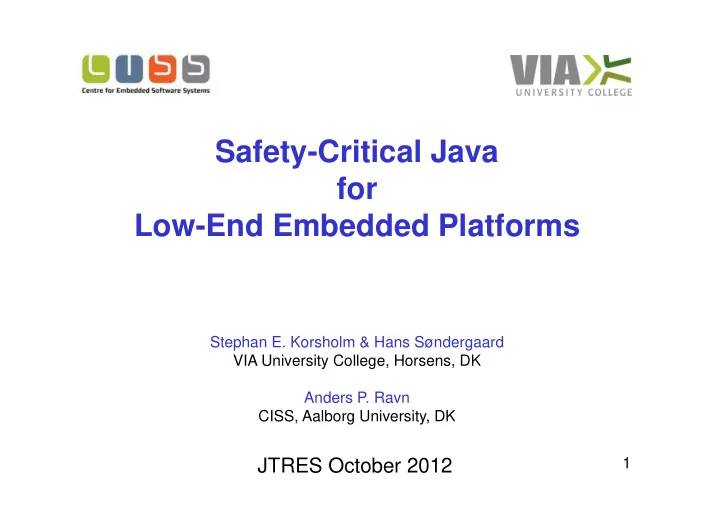

Safety-Critical Java for Low-End Embedded Platforms Stephan E. Korsholm & Hans Søndergaard VIA University College, Horsens, DK Anders P. Ravn CISS, Aalborg University, DK JTRES October 2012 1
The Problem Low-End Industrial Platforms • KT4585 from Polycom – ATMega2560 from AVR – NEC-V850 e.g. used by Grundfos – Typical memory resources – 16 kB RAM, 256 kB ROM Safety-Critical Java impl. using RTSJ • Based on Java RTS (SUN) – Recommended Requirements – CPU system with 512 MB Real-Time OS: Linux 2
Plan to Solve the Problem Reduce each layer of the architecture 3
Operating System No Operating System Instead: Hardware Objects for device control 1 st level interrupt handling in Java space Minimal native layer for context switch between tasks SCJ RTSJ JDK VM OS 4
VM: Hardware near Virtual Machine (HVM) Lean • – Java-to-C compiler with embedded interpreter – Program specialization – Classes & methods – Bytecode selection No dependencies on external libraries • Portable • SCJ – Strict ANSI-C RTSJ – All usual C compilers can be used JDK – Simple build procedure VM OS 5
JDK No special JDK required • – Uses Java 1.6 (Other JDKs supported as well) – Reduced through program specialization Dependency leaks • – System.out.println leaks, but – Collection classes (e.g. ArrayList) do not SCJ RTSJ JDK VM OS 6
7 SCJ JDK VM OS A bare metal implementation – The VM interface – No RTSJ SCJ •
Scoped Memory Scoped Memory: base Backing store size free 8
Scoped Memory Java: C: public class AllocationArea { protected int base; unsigned char * HVMbase; protected int size; uint32 HVMfree; protected int free; uint32 HVMsize; @IcecapCVar private static int HVMbase ; @IcecapCVar private static int HVMfree ; @IcecapCVar private static int HVMsize ; @IcecapCompileMe public static void switchAllocationArea(AllocationArea newScope, AllocationArea oldScope) { oldScope.base = HVMbase ; oldScope.free = HVMfree ; Scoped oldScope.size = HVMsize ; Memory : HVMbase = newScope.base; HVMfree = newScope.free; base Backing HVMsize = newScope.size; store } ... size free } 9
Scheduling Context switch through the layers • C C - Assembler Java Java 10
Real-Time Clock Platform specific • – E.g. KT4585, @IcecapCVar private static int systemTick ; – ATMega2560 Hardware clock – Configured using Hardware Objects – Tick interrupt handled in Java 11
Evaluation SCJ Level 1: • 1 Mission, 3 Handlers, KT4585 – ROM: 35 kB – RAM: 10 kB 12
Evaluation MiniCDj, ATMega2560 • – ROM – RAM, more than 300 kB 13
Related JVMs JamaicaVM • Hard real-time execution guarantees Real-time GC SCJ on top of RTSJ High-end embedded platforms FijiVM • Efficient Java-to-C compiler Real-time GC SCJ Level 0 with native function layer High-end embedded platforms KESO VM • Lean VM. Efficient Java-to-C compiler GC support HVM SCJ ported to KESO ? Low-end embedded platforms 14
Conclusion A SCJ Level 0 + 1 implementation for low-end platforms by means of: SCJ – A bare metal implementation of SCJ using a VMInterface – No special JDK required JDK – A lean and portable HVM, no library dependencies HVM – Hardware near features like Hardware Objects OS Typical memory resources 16 kB RAM, 256 kB ROM 15
Are we happy now? • Ensure SCJ compatibility • Development environment • Improve Java SCJ infrastructure • Learn efficient compilation from Fiji
Recommend
More recommend